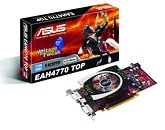- Joined
- Oct 9, 2007
- Messages
- 47,243 (7.55/day)
- Location
- Hyderabad, India
| System Name | RBMK-1000 |
|---|---|
| Processor | AMD Ryzen 7 5700G |
| Motherboard | ASUS ROG Strix B450-E Gaming |
| Cooling | DeepCool Gammax L240 V2 |
| Memory | 2x 8GB G.Skill Sniper X |
| Video Card(s) | Palit GeForce RTX 2080 SUPER GameRock |
| Storage | Western Digital Black NVMe 512GB |
| Display(s) | BenQ 1440p 60 Hz 27-inch |
| Case | Corsair Carbide 100R |
| Audio Device(s) | ASUS SupremeFX S1220A |
| Power Supply | Cooler Master MWE Gold 650W |
| Mouse | ASUS ROG Strix Impact |
| Keyboard | Gamdias Hermes E2 |
| Software | Windows 11 Pro |
Barely 24 hours into the launch of the Radeon HD 4770, ASUS has announced its factory-overclocked, and overclocker-friendly variant of the ATI Radeon HD 4770 (model: EAH4770 TOP/HTDI/512MD5). Giving it the "TOP" branding, the company upped the clock speeds, and backed the product with its Voltage Tweak technology, and its popular SmartDoctor performance control application. The gains end-users have compared to using a reference design accelerator are two fold.
First, ASUS set the clock speeds at 800 MHz (core), and 850 MHz (memory), both 50 MHz bumps over the reference AMD clock speeds of 750/800 MHz (core/memory). Second, using the value-added features, the voltages can be upped from 0.95 V to 1.2 V, increasing the overclocking headroom. ASUS claims the core could be set at freqencies as high as 971 MHz, and 1150 MHz for the memory: a seemingly massive increment over the reference speeds, which ASUS rounds off as a 35% speed improvement. The card retains the reference AMD design, and the most common cooler design partners are currently using. Its pricing and availability are yet to be known.

View at TechPowerUp Main Site
First, ASUS set the clock speeds at 800 MHz (core), and 850 MHz (memory), both 50 MHz bumps over the reference AMD clock speeds of 750/800 MHz (core/memory). Second, using the value-added features, the voltages can be upped from 0.95 V to 1.2 V, increasing the overclocking headroom. ASUS claims the core could be set at freqencies as high as 971 MHz, and 1150 MHz for the memory: a seemingly massive increment over the reference speeds, which ASUS rounds off as a 35% speed improvement. The card retains the reference AMD design, and the most common cooler design partners are currently using. Its pricing and availability are yet to be known.

View at TechPowerUp Main Site







 they all have the same cooler...
they all have the same cooler...